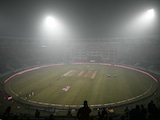Described as the world's most powerful telescope, NASA's James Webb telescope routinely captures stunning images of our universe, leaving space lovers mesmerized. The telescope recently captured a celestial spectacle named Arp 220-- an ultra-luminous infrared galaxy (ULIRG), that shines with light equal to more than a trillion suns.
Sharing the image, NASA Webb wrote, ''We love this with the fire of a trillion suns. Shown here is Arp 220, an ultra-luminous infrared galaxy (ULIRG) with a luminosity literally greater than that of a trillion suns. (It emits 300 times more light than the Milky Way!) Arp 220 glows brightest in infrared light, Webb's speciality.''
See the image here:
Describing the image, NASA Webb Telescope wrote, ''A black, deep space image is dominated by a large central object. This object resembles a snowflake-like feature with a bright white core and 8 pinkish-orange spikes. In reality, this “snowflake” is actually two colliding galaxies with merging cores. The brilliant light from the star formation surrounding these cores creates diffraction spikes, an optical effect that occurs when bright light interacts with a telescope's optics. The background is punctuated with scattered red, white and orange galaxies of various shapes and sizes.''
Arp 220 is actually two spiral galaxies in the process of merging, with a combined luminosity exceeding a trillion suns. In comparison, our Milky Way galaxy has a much more modest luminosity of about ten billion suns. Located 250 million light-years away in the Serpens constellation, Arp 220 is the nearest ULIRG and the brightest of the three galactic mergers closest to Earth. It is also the 220th object listed in Halton Arp's Atlas of Peculiar Galaxies.
According to NASA, an enormous burst of star formation was triggered by this galactic collision that commenced roughly 700 million years ago.
''This object is the result of a collision between 2 spiral galaxies that began about 700 million years ago, sparking a huge burst of star formation. The light from this star formation is shrouded in dust, which Webb can see through with its infrared vision,'' NASA explained.
NASA's Webb observed Arp 220 with its Near-Infrared Camera (NIRCam) and Mid-Infrared Instrument (MIRI).















